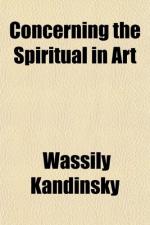But to a more sensitive soul the effect of colours is deeper and intensely moving. And so we come to the second main result of looking at colours: Their psychic effect. They produce a corresponding spiritual vibration, and it is only as a step towards this spiritual vibration that the elementary physical impression is of importance.
Whether the psychic effect of colour is a direct one, as these last few lines imply, or whether it is the outcome of association, is perhaps open to question. The soul being one with the body, the former may well experience a psychic shock, caused by association acting on the latter. For example, red may cause a sensation analogous to that caused by flame, because red is the colour of flame. A warm red will prove exciting, another shade of red will cause pain or disgust through association with running blood. In these cases colour awakens a corresponding physical sensation, which undoubtedly works upon the soul.
If this were always the case, it would be easy to define by association the effects of colour upon other senses than that of sight. One might say that keen yellow looks sour, because it recalls the taste of a lemon.
But such definitions are not universally possible. There are many examples of colour working which refuse to be so classified. A Dresden doctor relates of one of his patients, whom he designates as an “exceptionally sensitive person,” that he could not eat a certain sauce without tasting “blue,” i.e. without experiencing a feeling of seeing a blue color. [Footnote: Dr. Freudenberg. “Spaltung der Personlichkeit” (Ubersinnliche Welt. 1908. No. 2, p. 64-65). The author also discusses the hearing of colour, and says that here also no rules can be laid down. But cf. L. Sabanejeff in “Musik,” Moscow, 1911, No. 9, where the imminent possibility of laying down a law is clearly hinted at.] It would be possible to suggest, by way of explanation of this, that in highly sensitive people, the way to the soul is so direct and the soul itself so impressionable, that any impression of taste communicates itself immediately to the soul, and thence to the other organs of sense (in this case, the eyes). This would imply an echo or reverberation, such as occurs sometimes in musical instruments which, without being touched, sound in harmony with some other instrument struck at the moment.
But not only with taste has sight been known to work in harmony. Many colours have been described as rough or sticky, others as smooth and uniform, so that one feels inclined to stroke them (e.g., dark ultramarine, chromic oxide green, and rose madder). Equally the distinction between warm and cold colours belongs to this connection. Some colours appear soft (rose madder), others hard (cobalt green, blue-green oxide), so that even fresh from the tube they seem to be dry.
The expression “scented colours” is frequently met with. And finally the sound of colours is so definite that it would be hard to find anyone who would try to express bright yellow in the bass notes, or dark lake in the treble.




